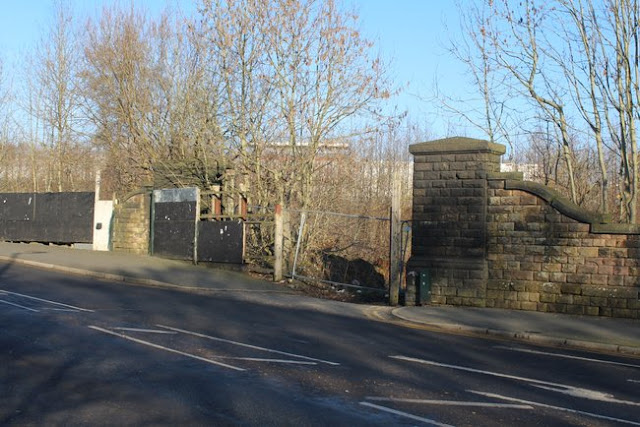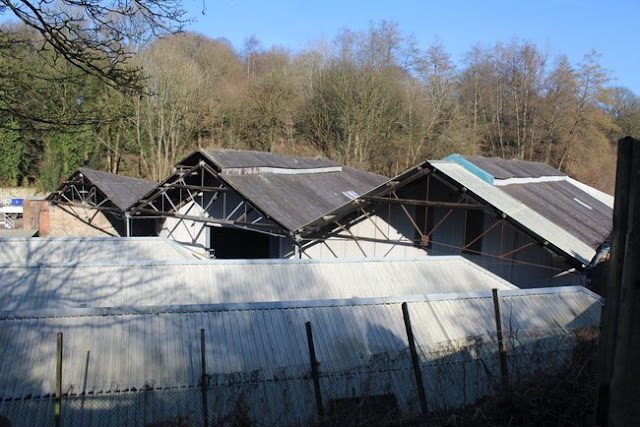Starting Point - Oldham Mumps Tram Stop. Finishing Point - Aston under Lyne Station.
Distance 5 Miles
Following on from my recent visit to the Oldham Loop line I dug bag through my photos to an earlier visit to the nearby Oldham, Ashton under Lyne and Guide Bridge Junction Railway. Much of the route is walkable, though there isn't much to see in terms of former railway structures. The route does have some interesting bits to see of the industrial heritage alongside the former railway though.
The OA&GB was a Joint Line operated by the Manchester, Sheffield & Lincolnshire Railway (later Great Central Railway) and the London & North Western Railway. With these two companies becoming parts of the LNER and LMS in the grouping of 1923 the OA&GB survived the grouping and continued as a joint line operation until both companies became part of British Railways in the 1948 nationalisation. Passenger services were discontinued in 1959 and the line closed completely in 1968. More information about the history of the line can be found in the Wikipedia article.
Oldham Glodwick Road
The OA&GB connected end on to the L&NWR's Delph Donkey branch line at Oldham Glodwick Road station. The station itself was in a slight cutting which has been filled in and landscaped over, the site of the station is now an area of grass at the corner of Glodwick Road and Southlink. The former goods shed does survive though on the south side of Hamilton Street.
The OA&GB line ran to the south of the Lancashire & Yorkshire line through Oldham, the Oldham Loop I covered earlier. Originally the MS&LR had intended to form the joint line with both the L&YR and the LNWR but the two rivals would not work together and the L&YR pulled out.
Oldham Clegg Street
Clegg Street station on the Ashton line was next to the L&YR's Oldham Central. After closure of the railway the site of Clegg Street station was used to build a parcels depot. In recent years the site has been redeveloped and is now occupied by the Alexandra Retail Park. The LNWR goods shed on the corner of Park Road and Woodstock Street survived in to recent years but the unsafe condition of the building resulted in its demolition in 2012.
Below - Gateposts of the former LNWR goods yard. The retail park on the site of Clegg Street station can be seen through the trees.
On the approach to Ashton a few of the bridges over the railway survive, I don't know why I didn't get photos of these.
The footpath emerges on to Turner Lane where the line went in to a tunnel under Lordsfield Avenue. At the other end of this short tunnel was Ashton Oldham Road station
Ashton Oldham Road
1935 Map (top right of map)
The Berkeley Business park has been built on the site of the railway south of the tunnel and the south portal of the tunnel is obscured by buildings (but can be seen on ariel photos). No trace of the station site can be seen today. The western parapet of the filled in bridge under Oldham Road survives.
The line crossed the surviving L&YR line between Manchester Victoria and Stalybridge, heading southwest through what is now a Sainsburys store. The IKEA store occupies the site of the goods yard. In 1911 the Ashton Moss Curve was added by the GCR to form a triangular junction with the L&YR, this curve and a short section of the OA&GB survives as a freight route through the former LNWR line to Stockport.
At the centre of the above map is the National Gas Engine works. The former works survives as the Kayley Industrial Estate.
Below - The former National Gas Engine works.
Ashton Moss
Just off Knight Street was the former Ashton Moss station which was in use for less than a year when the line opened in 1861.
1894 Map (left side of map)
South of Ashton Moss station the LNWR's Guide Bridge Junction line went off to Stockport and this survives. The triangular junction on to the GCR line through Guide Bridge has been removed, until recent years it could be clearly seen from passing trains (also with former Woodhead Route electrification masts) but is quite overgrown now. The LNWR line from Guide Bridge to Stockport has just one passenger train a week from Stalybridge to Stockport. Occasionally the connection from Ashton Moss Curve has been used for charters or diverted mainline trains to access the line through Stockport from Manchester Victoria rather than Manchester Piccadilly. I have previously travelled this route on a charter and on a diverted Cross Country service. There were no passenger trains this way on this trip so I walked to Ashton under Lyne station for a train home.










.JPG)
.JPG)
.JPG)
.JPG)









.JPG)
.jpg)
.jpg)
.jpg)


.jpg)




.jpg)
.jpg)
.jpg)
.jpg)
.jpg)
.jpg)
.jpg)
.jpg)
.jpg)




.jpg)
.jpg)




.jpg)
